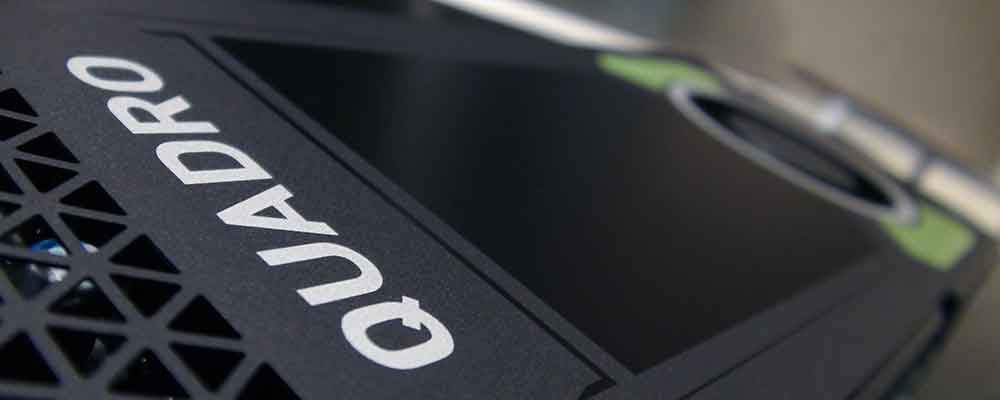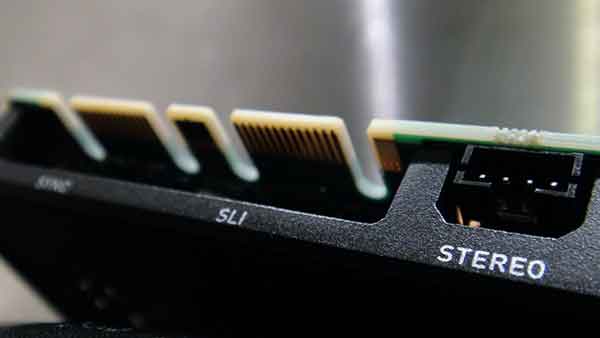
For many people, 1664 is a not-so-great-tasting French beer. For PW, it is the number of CUDA cores on a Quadro M4000. Check out the performance and the possibilities ...
The NVIDIA Quadro M4000 is a Maxwell-based Quadro GPU (GM204) announced at Siggraph 2015. Along with 8GB of GDDR5, 4 DisplayPort outputs, 4K monitor resolution support, SLI, Stereo, and Sync support, this is a GPU with power and potential that comes in at a price around $1000.
 PW tested the GPU in a new Skylake workstation with the Intel Xeon E3-1275 v5 clipping along at 3.6 GHz. Scroll down to jump to the performance numbers. We'll start with a look at the outside of this new professional GPU.
PW tested the GPU in a new Skylake workstation with the Intel Xeon E3-1275 v5 clipping along at 3.6 GHz. Scroll down to jump to the performance numbers. We'll start with a look at the outside of this new professional GPU.
NVIDIA now supports more DisplayPort outputs and can drive four 4K resolution displays from the Quadro M4000
The Quadro M4000 replaces the K4200 and corrects several deficiencies in the older GPU. First, it increases display support to 4 outputs - this time all of them are DisplayPort. Apparently, the K4200's Kepler architecture could not support 4 DisplayPort outputs which the Maxwell architecture does. This allows the Quadro M4000 to support a modern display configuration.
The K4200's 4GB of GDDR5 memory has been increased to 8GB - another point where the Santa Clara graphics experts needed to play catch-up. While there are certain graphics situations which like the extra 4GB of memory, it is critically important for CUDA and GPU-computing applications in areas like simulation. The memory has a 256 bit interface and a 192 GBps bandwidth which places the M4000 memory performance close to its big brother the M5000 and much faster than the K2200 and K1200 GPUs.
 The Quadro M4000 has a total power consumption of 120W and requires an extra connector for the back of the board. None-the-less, it remains a single-slot design. On the top of the board are 3 connectors for SLI support, Stereo, and Display Sync which support high-end professional features needed for CAVEs, VR, and complex display systems.
The Quadro M4000 has a total power consumption of 120W and requires an extra connector for the back of the board. None-the-less, it remains a single-slot design. On the top of the board are 3 connectors for SLI support, Stereo, and Display Sync which support high-end professional features needed for CAVEs, VR, and complex display systems.
If you are familiar with the SPEC.ORG benchmark, Viewperf 12, then you will know that the results are a weighted FPS value for each of the data sets. And even if Viewperf is designed to isolate the GPU performance from the rest of the workstations and to load the GPU as much as possible, it is still clear from the results below, that a Quadro M4000 won't be the choice for simpler or even moderately complex 3D work.
In the end, testing with your specific set of applications is important. We run into surprising results ourselves from time to time.
 The power and features of the Quadro M4000 target much higher-end applications
The power and features of the Quadro M4000 target much higher-end applications
For example, PW tested the Quadro M4000 and its little brother, the K1200 together. Despite the naming convention, both GPUs are based on the Maxwell architecture. We ran our performance tests and then we setup both with some demanding Adobe video applications: Premier Pro CC and After Effects CC. You will find the details in this article, Which NVIDIA Quadro for Adobe Video?. In this case, we found a situation where less-is-more. Although Premier Pro CC uses GPU rendering and even though video rendering can consume a lot of processing power, the Adobe implementation gets exactly the same performance from the Quadro M4000 as it gets from the Quadro K1200. In the second case, After Effects CC demands even more computing power than Premier Pro. Unfortunately, Adobe has been reducing the number of cases which leverage the GPU rather than increasing the use of the GPU. In the end, the Quadro K1200 is the better choice for these applications.
Therefore, you can see that the power of the GPU, the 8 GB of memory, and the specialized connectors combine to make the Quadro M4000 destined for demanding jobs: high-end 3D modeling, interactive realistic visualization, stereo displays, and VR headsets. With a single-slot design, it can also be used in multiple GPU, single-system CAVE environments. To provide some concrete examples, this means that uses like 3D modeling in 3ds Max absolutely don't need this kind of power unless you are using NVIDIA's own ray-tracing renderers. On the other hand, realtime visualization with Autodesk's VRED or 3Dexcite's Deltagen can definitely use the power of the Quadro M4000.
The PW Perspective
We like fast graphics and the Quadro M4000 qualifies. The update to four DisplayPort outputs and building a full 8GB of memory on the board are welcomed upgrades from the K4200. The performance of the GPU in 3D puts it out of range for basic CAD & 3D modeling applications. This GPU is destined for more demanding 3D and more demanding GPU-computing applications - GPU-based ray-tracing and simulation are examples of the latter. As we found in our tests with Adobe software, it is disappointing that Premier Pro and After Effects don't leverage the power of this GPU - they certainly need the performance boost! The fault for that more likely resides at Adobe than at NVIDIA. On the other hand, NVIDIA has a world-class developer program which means they have the expertise and the manpower to support important software developers.
None-the-less, high-end applications which can use this level of performance abound and users that need high performance and the extra features of the Quadro M4000 will find the price a bargain.
The Quadro M4000's Benchmark Performance
Viewperf 12.0
| Viewset | Composite | Window | ||||||
|---|---|---|---|---|---|---|---|---|
| 85.02 | 1900 x1060 | |||||||
| 72.44 | 1900 x1060 | |||||||
| 5.74 | 1900 x1060 | |||||||
| 69.97 | 1900 x1060 | |||||||
| 25.25 | 1900 x1060 | |||||||
| 42.96 | 1900 x1060 | |||||||
| 75.50 | 1900 x1060 | |||||||
| 111.26 | 1900 x1060 | |||||||
| Graphics Hardware Configuration | |
|---|---|
| Graphics Accelerator | NVIDIA Quadro M4000 |
| Graphics Driver Version | 10.18.13.5413 |
| Display Resolution | 3840x2160 @ 32 bpp |
| Display Size/Technology | 45.7" |
| Display Refresh Rate | 59 Hz |
| Display Name | N/A Hz |
| System Hardware Configuration | |
| Manufacturer | FUJITSU |
| Model | D3417-A2 |
| Processor Type | Intel(R) Xeon(R) CPU E3-1275 v5 @ 3.60GHz |
| Processor Base Frequency | 3601 MHz |
| Number of Populated Processor Sockets | 1 |
| Number of Physical Cores per Processor Socket | 4 |
| Number of Logical Cores per Processor Socket | 8 |
| Number of Processor Threads per core | 2 |
| L1 Cache per Socket (KB) | 256 |
| L2 Cache per Socket (KB) | 1024 |
| L3 Cache per Socket (KB) | 8192 |
| System Memory | 16GB |
| Memory Type | DDR3 |
| Memory Speed | 2133 MHz |
| Memory Configuration | 8GB , 8GB |
| Disk Model | SAMSUNG MZHPV256HDGL-00000 ATA Device |
| Disk Size | 238.47GB GB |
| Software Configuration | |
| Operating System | Microsoft Windows 7 Professional 64-bit |





